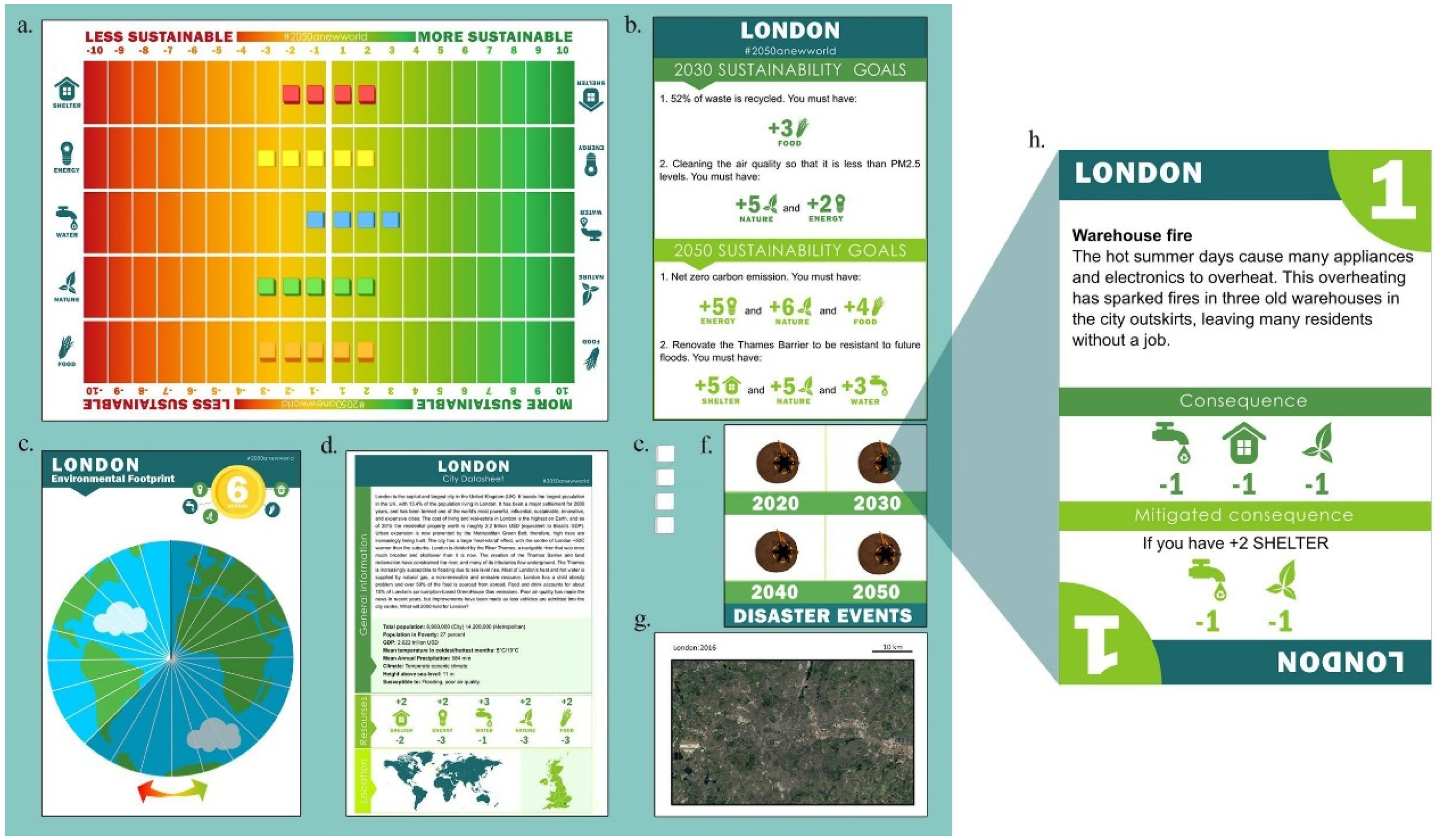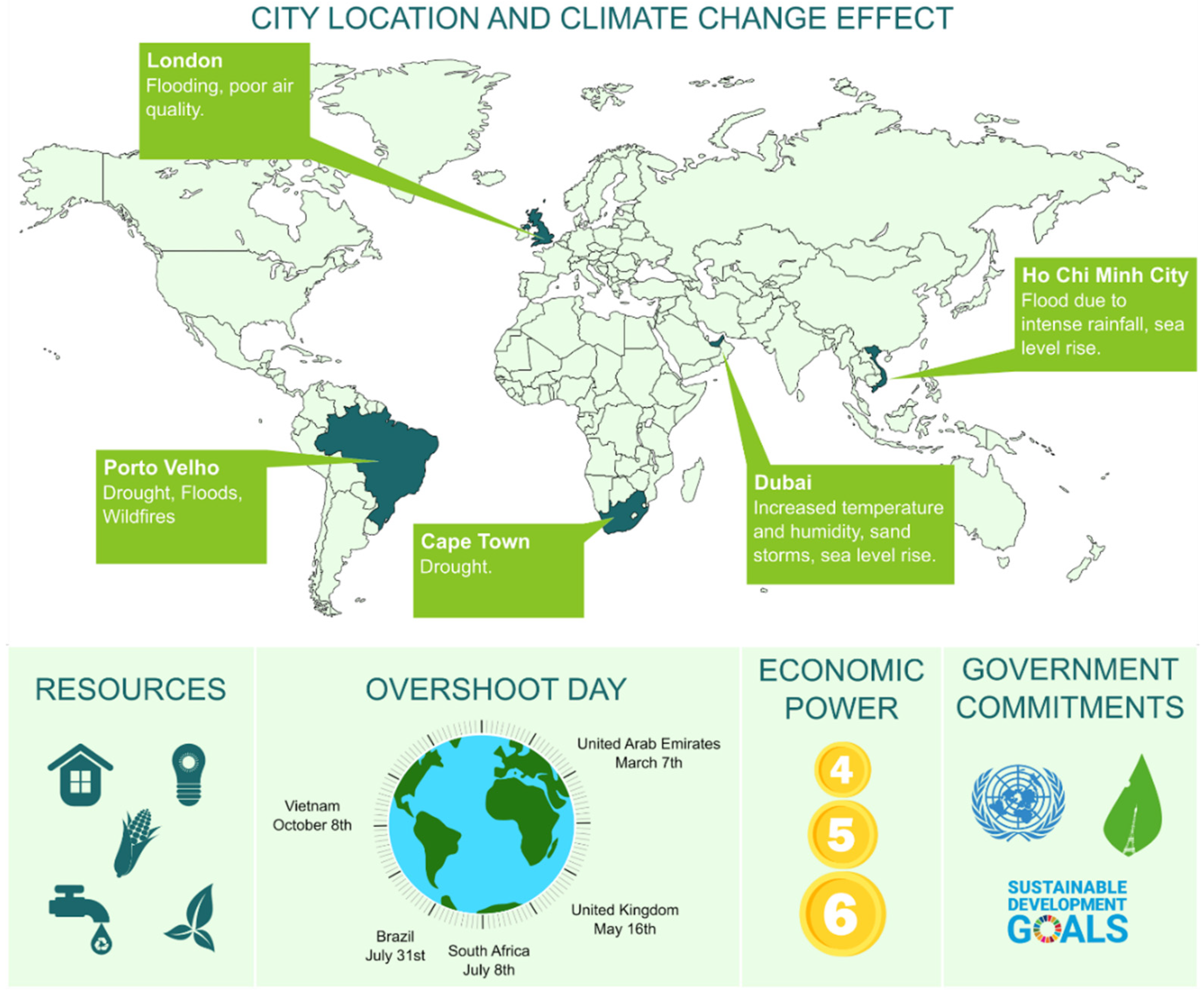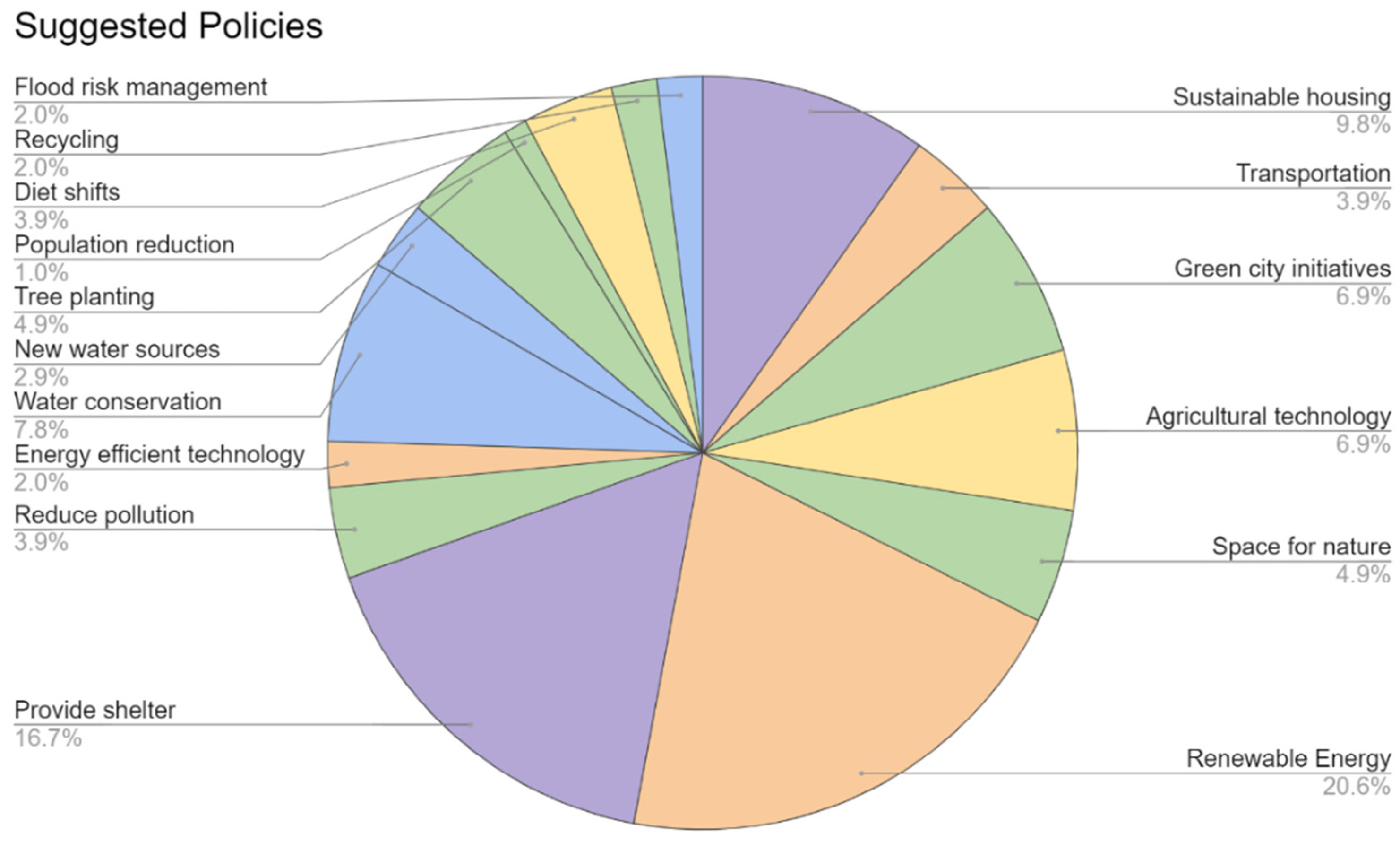1. Introduction
Contemporary climate change has had detrimental effects across the world, and current projections anticipate these effects will grow worse as we approach the year 2050 and beyond [
1]. Shifts in climate and resource availability are predicted throughout the next several decades, without a significant reduction in global greenhouse gas emissions, which poses a substantial risk to human welfare and natural ecosystems [
1,
2,
3,
4], and demonstrates the urgency for action to secure a sustainable future. Climate change can also act synergistically with human actions and environmental degradation [
1,
5] and the consequences of the processes have severe implications for human wellbeing in the short and long term.
National and local governments have the responsibility of keeping their populations safe, and there are now many examples of governments acting to reduce threats from climate change. For example, UN states members adopted the Sustainable Development Goals (SDGs) [
6]: a universal call to “end poverty, protect the planet and ensure that all people enjoy peace and prosperity”; the UK committing to net-zero carbon emissions by 2050 [
7]; the UN Convention on Biological Diversity agreed to the 20 Aichi Biodiversity targets [
8] among others.
Despite substantial progress as a result of international commitments on sustainability, significant challenges remain if global warming is to be limited to 1.5 °C of warming by 2100 [
1]. Whilst these targets have been helpful in defining the problem across cultures and providing a universal vocabulary with which to pursue further progress, achieving these targets remains a challenge. One component of this challenge is finding viable solutions for specific national or local contexts.
To overcome the difficulty of implementing large-scale initiatives in a local framework, interdisciplinary effort and effective public engagement are crucial. Recently, a survey conducted by The Climate Communication Project among 178 climate communicators, stated that greater engagement is achieved when we: “help the audience to realise what they can do themselves and realise key actions they can take; encouraging a sense of control and efficacy” [
9], suggesting that dialogue and co-production is an effective means in engaging people about climate change. The survey further suggests that creative methods of communication are highly valued for reaching less-engaged audiences.
One method of communicating the impact of climate change and the need for complex policies and trade-offs is to “gamify” the problem. Games may communicate complex situations in an engaging, accessible fashion, and empowers the players to make decisions in low-risk, simulated environments. Uniquely, games can condense decades of action and consequences into a relatable time frame and expose players to numerous ways in which climate impacts our world. By balancing gameplay with a sense of genuine risk and feasible success, the gamification of climate change mitigation and sustainable development can engender a motivation to drive change [
10,
11].
With a desire to encourage public dialogue around climate change, and to communicate the variety of challenges being faced around the world, we launched the policy-based board game 2050: A New World as an interdisciplinary tool for engaging the public, allowing them to guide the future of their cities and design their own solutions to climate change. The game is delivered in a workshop setting, with the objective of communicating the difficult trade-offs involved in sustainably managing resources and successfully combating climate change.
2. Experimental (Gameplay)
When generating decisions about climate change mitigation, it is critical to balance difficult trade-offs to raise awareness about our individual priorities. The development of 2050: A New World started by asking the question to policymakers and citizens: what are they willing to change to shape a society resilient to climate change? To probe public response, we utilized the interactive platform provided in a board game to position the player as a city planner, free to creatively envision the change they would like to see in the world by 2050. The objective of the game is to meet a set of international commitments on resource sustainability by 2050 whilst preventing regional environmental collapse. Improvements towards goals are made by creating policies that result in a shift in resource availability or sustainability.
Representing the full complexity of climate change on a global scale is an impossible task for any board game. Our priorities are: 1. Acknowledge the diversity of needs and resource availability present across the developed and developing world, and the different challenges that communities face as a result; 2. Communicate that the resources we rely on are interlinked; and 3. Demonstrate that the impact of climate change is not the same everywhere, and decisions to minimise damage are time-sensitive. The game is based in five cities, purposefully selected to represent different parts of the world with different resources at their disposal, and with different challenges to overcome. These cities are: London (UK), Dubai (United Arab Emirates), Porto Velho (Brazil), Cape Town (South Africa) and Ho Chi Minh City (Vietnam). Each team of up to six players takes control of one city, and together they progress through the game.
The board game platform allows us to communicate to the public about our ongoing research related to climate change adaptation and mitigation and opens up a dialogue for inclusive learning. We divided the game board into five different “resources”: food, nature, water, shelter, and energy (
Table 1 and
Figure 1). All five resources represent basic human needs while also reflecting our different areas of expertise. Grouping the resources into broad categories gives players the freedom to develop their city in a multitude of ways. Each city has its own resource board, and furthermore, its own potential. The abundance of a resource is reflected by the number of cubes, and their position illustrates how sustainably the remaining resources are being used. For example, while Dubai holds a great capacity in energy resources, the fact that its current energy use is based on oil and gas (i.e., non-renewable) negatively impacts how its energy resource is positioned, resulting in large, negative score for that resource, thus, encouraging the players to create policies to invest in more sustainable energy.
The game is played in four rounds, where each round represents a decade of policy development (2020, 2030, 2040 and 2050). At the beginning of each round, and as the core of the game, players create policies to strategically reallocate or improve their resources towards their international sustainability commitments (
Figure 1a,b). Each city has its own sustainability goals, formulated based on its actual SDGs, 2015 Paris Agreement Commitments, and national sustainable development plans. These goals are translated into a resource balance that the city must achieve by the appropriate deadline. There are two goals to be fulfilled by 2030, and another, more challenging pair, by 2050. When working towards these targets, players can reallocate cubes between different resource categories or make a specific resource type more sustainable. Importantly, as in the real world, the amount of resources for each city is limited, forcing careful decisions about resource allocation. Players are prohibited from depleting any resources.
Resource reallocation was implemented in an attempt to represent real-life trade-offs, e.g., deforestation to introduce arable lands, where humans sacrifice nature and biodiversity to obtain food, or the allocation of water resources for crop irrigation to improve yields. The number of policies that players can implement each decade is also limited in accordance with the city’s wealth (see
Figure 2), but choices about whether to prioritise achieving their goals, improve their least sustainable resources, or prepare their city for climate change (discussed below) are determined by the players. We require participants to document their policies and resource movements on a timeline to record their ideas.
The balance of a city’s resources not only determines whether a team wins the game by achieving their sustainability goals, but also has a significant impact on the environment and responses to climate change. After players have decided on the policies they implement that decade, they will be faced with a climate change-driven disaster that threatens to set back their progress (
Figure 1f,h). The disaster is selected randomly from a series of tailored events for each city, and as the game progresses more severe events are added in response to global warming. The events are inspired by historic events and climate predictions, and include tropical cyclones, heatwaves, civil unrest, and droughts. Players are provided with vague information about the biggest threats to their region in the city datasheet (
Figure 1d), but crucially, they must adapt as events unfold and account for an uncertain climate in order to effectively manage their resources. The consequences of each climate event will depend on how much players have invested in the sustainability of the systems being affected. A lack of sustainability or resilience causes larger problems that cascade to multiple resource systems, whereas a more robust system is less affected and contains the consequences. This feedback often results in players identifying critical resources and tipping points that will be required for them to succeed.
To incorporate the role that social movements play in aiding sustainable resource usage and in responding to disaster events (as opposed to top-down legislation) players are allowed to promote one social initiative after each disaster by allocating one spare cube (
Figure 1e) to a resource of their choice. This reflects a resource being used with greater efficiency and communicates the importance of behavioural changes in achieving sustainability, such as dietary change or reducing air travel.
At the end of each round, we assess the impact that resource usage has on the environment. For every resource with a negative score, players erode the remaining capacity of the environment to support unsustainable resource use. This is captured in their environmental footprint record, and all cities start at different stages of environmental degradation (
Figure 1h for an example). The starting position is determined based on the Earth Overshoot Day [
12] or each country (see
Figure 1c and
Figure 2). If the environment becomes completely degraded, the game is over. Failure to complete sustainability goals will also worsen the environmental footprint, the only way to repair some of the damage is to pass other goals.
3. Results and Discussion
The game was presented for the first time in front of three different cohorts at the Cambridge Festival of Ideas 2019 hosted by the University of Cambridge. The session invited people ages 10+, and included families, teenagers, adults and senior citizens. This myriad of ages, backgrounds and expertise provides a unique framework for debate and discussion on complex and sometimes contentious topics, including deforestation, diet, and the use of transgenic crops. One of the strengths of 2050: A new world as a public outreach tool is that it allows players to judge the effectiveness of their own policies, and the subsequent actions to pursue, through debate and discourse. This makes the game accessible to a wide demographic, independent of prior knowledge. The content of the policies reflects the opinions and perceptions of the players, about what is an acceptable or desirable way of making society more sustainable, whilst the gameplay communicates fundamentals about the challenge of achieving that ultimate goal.
We observed extensive and sensitive debates amongst groups. The children players exhibited a vigilant and urgent approach to climate change. This age group often presented creative ideas, including: the reduction of air travel; teaching school children to grow food on small scales for self-sufficiency and nutrition; roof garden cultivation; stronger regulations for protecting woodlands and greenbelts; the rehabilitation of derelict buildings over new constructs. The policies generated over the course of the workshop have been summarised in
Figure 3. To allow players creative freedom and to keep the game accessible, policy feasibility/sustainability was inconsequential.
The policies implemented by players often reflected traditional means of development, particularly when the motivation was linked to relieving acute pressures on the population. For example, teams playing in cities with large vulnerable or homeless populations often implemented a series of unsustainable policies involving extensive construction (16.7% of policies). On the one hand, this reflects the genuine priorities of the players, and on the other, it highlights where more could be done to communicate the problems with large-scale construction and the possibilities of alternative development routes, including novel building designs and alternative building materials.
Despite the plant blindness effect [
13], most teams acknowledged the potential for plants to contribute to sustainable development. A relatively large proportion of policies (6.9%) involved increasing the amount of vegetation present in cities for purposes that included reducing pollution, food production, and supporting biodiversity. These initiatives are extremely popular with players, suggesting wider public support for these initiatives may also be high. More generally, however, there was little evidence that players were considering the role of plant diversity, or of different species and habitats in the success of initiatives like widespread tree planting. This suggests more could be done to engage with the public on these topics, particularly given current initiatives to restore forests under the Bonn accord and national tree-planting targets such as the UK’s aim to plant 11 million trees by 2022. While new agricultural technologies made up 6.9% of policies, the majority of them involved greater irrigation or the use of greenhouses. Genetically modified crops and hydroponic agriculture were only mentioned once, respectively. On the other hand, veganism and the promotion of “green thumbs” in the community were mentioned as social behaviour changes on multiple occasions. This suggests that while players were aware of the potential for plants to help society adapt to and reduce climate change, there is less willingness to accept new plant-based technologies.
4. Conclusions and Future Outlook
Overall, the game was warmly received among participants and fellow science communicators. In a feedback survey, 75% of the responses for our event rated it with 5 out of 5. In view of this positive feedback, experts on science outreach invited us to run again during the Cambridge Science Festival, expected to occur in March 2020 and also in the Pre-University Summer Programme, University of Cambridge. However, considering COVID-19, these events were cancelled. To adapt to such circumstances, we have since altered the game format to make it more accessible to people in their homes. We have implemented a mix of freely available online platforms that allow us to replicate the experience of an in-person workshop as closely as possible. We hope that, with 2050: A new world now freely available online, we will be able to reach diverse audiences around the world, allowing us to identify policy preferences in a much wider cohort and to continue to learn from this process. We are also pursuing a Print-and-Play version of the game, primarily targeted at classroom environments, as a free teaching aid on the topic of sustainability. We further envision the game as a resource for a classroom project, in which students research different aspects of sustainable development in their city and the consequences of climate change, prior to playing the game. We have intentionally contracted an open Creative Commons license for the game so that 2050: A new world can be accessed around the world for free. For further inclusion, we aim to translate the game components into multiple languages.
Despite the current obstacles to prioritising sustainable development and reducing CO
2 emissions due to the COVID-19 pandemic, we think it is important to continue dialogues about the risks posed by climate change and the challenges of sustainable resource use. It has been suggested that COVID-19 offers us a “reset” button [
14]. We hope that
2050: A new world will continue to be a platform that fosters solutions, engages the public, and boosts awareness of important global issues towards a more sustainable future.














